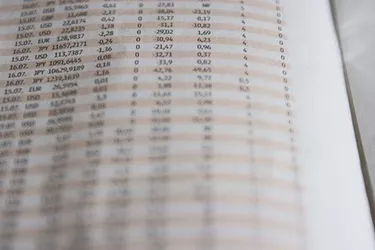
A stock's beta theoretically measures price sensitivity compared with the market. Investors with multiple positions should consider their portfolio's beta. Sophisticated investors may want to take a closer look at beta measurement.
Calculation of beta requires a time horizon as well as measurement against a market standard, such as the S&P 500. International equities, a short- or long-term horizon and other factors affect beta. You should learn how to calculate your portfolio's beta for the greatest accuracy.
Video of the Day
Video of the Day
Step 1

Calculate the beta of your portfolio to position your holdings for moves with the market, according to "Modern Portfolio Theory and Investment Analysis" (2009).
The concept of investment timing requires the adjustment of portfolio beta prior to market moves. For example, when an investment manager believes the market is about to rise, she may adjust the portfolio's beta higher to create additional upward price sensitivity for portfolio holdings. Use beta to calculate price sensitivity in equity and equity and debt portfolios.
Step 2

Compute beta using a simple calculation when your portfolio contains securities from one marketplace, such as the S&P 500. According to the authors of "Financial Management" (2007), "Beta is established from past information on the assumption that it will remain fairly stable over time." In the authors' example, portfolio beta is the weighted average of the individual betas of securities in the portfolio.
Step 3

Use Excel or spreadsheet software to calculate and recalculate portfolio beta according to market, marketplace conditions and other factors. Know how to create a spreadsheet that will capture information at a glance, and automatically update your portfolio's beta.
Beta is seldom a static number, so the dynamic relationship of your portfolio's beta to the overall market, while best reflecting your investments, may help you best manage your money.
Step 4

Calculate the beta of your investments when evaluating the risk-to-reward potential of your portfolio. For example, when your portfolio contains overweighted positions of any security, your calculation should reflect the overweighting. A security assuming 40 percent of portfolio value is not the same as one assuming 10 percent.
In this example, 10 percent of the portfolio is invested in a lower-than-market beta stock (0.8, where the market is 1.0); 20 percent is invested in a higher than market beta stock (1.4); 30 percent is invested in a higher than market beta stock (1.8); and 40 percent is invested in a higher than market beta stock (1.9). The calculation, (0.10)(0.8) + (0.20)(1.4) + (0.30)(1.8) + (0.40)(1.9) = 1.67, shows the portfolio beta is high relative to the market.
The portfolio's owner believes the market is going to rise. However, overall portfolio risk would be better managed with greater position diversification.
Step 5
Understand that derivatives, structured products and options have beta coefficients relative to the market. When calculating your portfolio beta, include these securities for an accurate picture. While calculations are complex, knowing how much risk your portfolio bears is essential to sound money management.
Tip
Use many resources to learn more about portfolio management.
Warning
Beta coefficients may not accurately describe the risk associated with any security.
This is not an offer to buy or sell securities and does not constitute investment advice.